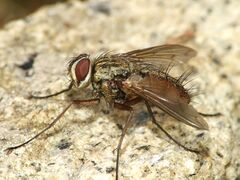Biology:Dexia rustica
| Dexia rustica | |
|---|---|

| |
| Dexia rustica. Dorsal view | |
| Scientific classification | |
| Domain: | Eukaryota |
| Kingdom: | Animalia |
| Phylum: | Arthropoda |
| Class: | Insecta |
| Order: | Diptera |
| Family: | Tachinidae |
| Subfamily: | Dexiinae |
| Tribe: | Dexiini |
| Genus: | Dexia |
| Species: | D. rustica
|
| Binomial name | |
| Dexia rustica (Fabricius, 1775)[1]
| |
| Synonyms | |
| |
Dexia rustica is a species of fly in the family Tachinidae.[10]
Distribution and habitat
British Isles, Czech Republic, Hungary, Latvia, Moldova, Poland , Romania, Slovakia, Ukraine , Denmark , Finland , Sweden, Albania, Bosnia and Herzegovina, Bulgaria, Croatia, Greece, Italy, Portugal, Serbia, Slovenia, Spain , Turkey, Austria, Belgium, France , Germany , Netherlands, Switzerland , Iran, Israel, Mongolia, Russia , Transcaucasia.[10]
These tachinids usually inhabit hedge rows and flowery environments.[11]
Description
Dexia rustica can reach a body length of 8.4–12.7 millimetres (0.33–0.50 in) and a wingspan of 16–24 mm.[12] These small tachinids have generally a black thorax, with grayish yellow pruinosity. Four longitudinal black vittae appear on dorsum,[13] Abdomen appears greyish-brown or reddish, with a darker longitudinal dorsal marking, more or less evident. It is cylindric-conic, with two setae among each segment. Probocis is short and membranous.[14] Females usually are darker than males.[15][11] Wings are hyaline, with a reddish yellow tegula and a dark brown basicosta. Legs are reddish yellow.[13]
Biology
Adults can be found from June to August,[11][12] feeding on nectar and pollen, especially of Heracleum sphondylium.[12]
Larvae develop in the soil feeding on beetle larvae (endoparasitism),[11] mainly of Melolontha melolontha,[12] Amphimallon solstitialis, Rhizotrogus marginipes[13] and Phyllopertha horticola (Scarabaeidae).[16]
References
| Wikimedia Commons has media related to Dexia rustica. |
- ↑ 1.0 1.1 Fabricius, J.C. (1775). Systema entomologiae, sistens insectorum classes, ordines, genera, species, adiectis synonymis, locis, descriptionibus, observationibus.. Flensbvrgi et Lipsiae [= Flensburg & Leipzig]: Kortii. pp. [32] + 832. https://www.biodiversitylibrary.org/item/82400#page/5/mode/1up. Retrieved 20 February 2021.
- ↑ Meigen, J.W. (1826). Systematische Beschreibung der bekannten europäischen zweiflügeligen Insekten. Funfter Theil.. Hamm: Schulz-Wundermann. pp. xii + 412 pp.. https://www.biodiversitylibrary.org/item/45843#page/9/mode/1up. Retrieved 12 November 2023.
- ↑ 3.0 3.1 Robineau-Desvoidy, J.B. (1830). "Essai sur les myodaires". Mémoires présentés par divers savans à l'Académie Royale des Sciences de l'Institut de France (Sciences Mathématiques et Physiques) 2 (2): 1–813. https://www.biodiversitylibrary.org/page/3472165#page/9/mode/1up. Retrieved 7 January 2022.
- ↑ Macquart, J (1834). "Insectes Diptères du Nord de la France. Tome V. Athericères: Créophiles, Œstrides, Myopaires, Conopsaires, Scénopiniens, Céphalopsides. Daniel L, Lille, 232 pp.". Mémoires de la Société Royale des Sciences, de l'Agriculture et des Arts, de Lille 1833: 137–368.
- ↑ Robineau-Desvoidy, Jean-Baptiste (1863). Histoire naturelle des dipteres des environs de Paris.. Tome second. Masson et Fils, Paris.. pp. 1–920. https://archive.org/download/histoirenaturell02robi/histoirenaturell02robi.pdf. Retrieved 15 February 2015.
- ↑ Gmelin, J.F. (1790). Caroli a Linne, Systema naturae per regna tria naturae, secundum classes, ordines, genera, species; cum caracteribus, differentiis, synonymis, locis. Editio decima tertia, aucta, reformata [= Ed. 13. Vol. 1: Regnum Animale]. Lipsiae [= Leipzig]: G.E. Beer. pp. Pt 5, Pp. 2225–3020. https://www.biodiversitylibrary.org/item/83099#page/5/mode/1up. Retrieved 8 December 2022.
- ↑ Stephens, J.F. (1829). A systematic catalogue of British insects ... Part II. Insecta Haustellata. London: Baldwin & Cradock. pp. 388 pp.
- ↑ Fabricius, J.C. (1781). Species insectorum. 2. Hamburgi et Kilonii [= Hamburg and Kiel]: C. E. Bohnii. pp. 494.
- ↑ Harris, M. (1780). An exposition of English insects. Decads III, IV. London: Robson Co.. pp. 73–99, 100–138, pls. 21–30, 31–40. https://www.biodiversitylibrary.org/item/226006#page/5/mode/1up. Retrieved 16 July 2021.
- ↑ 10.0 10.1 O’Hara, James E.; Henderson, Shannon J.; Wood, D. Monty (5 March 2020). "Preliminary Checklist of the Tachinidae (Diptera) of the World". http://www.nadsdiptera.org/Tach/WorldTachs/Checklist/Tachchlist_ver2.1.pdf.
- ↑ 11.0 11.1 11.2 11.3 Bob Gibbons Field Guide to Insects of Britain and Northern Europe
- ↑ 12.0 12.1 12.2 12.3 J.K. Lindsey Commanster
- ↑ 13.0 13.1 13.2 Chun-Tian Zhang, Xiao-Lin Chen A review of the genus Dexia Meigen in the Palearctic and Oriental Regions Diptera Tachinidae in Zootaxa · December 2010
- ↑ John Obadiah Westwood An Introduction to the Modern Classification of Insects Vol II (1840)
- ↑ James E. O'Hara, Hiroshi Shima, & Chuntian Zhang. "Annotated Catalogue of the Tachinidae (Insecta: Diptera) of China." Zootaxa 2190 (2009): 1-236.
- ↑ Encyclopedia of life
Wikidata ☰ Q5268322 entry
 |


